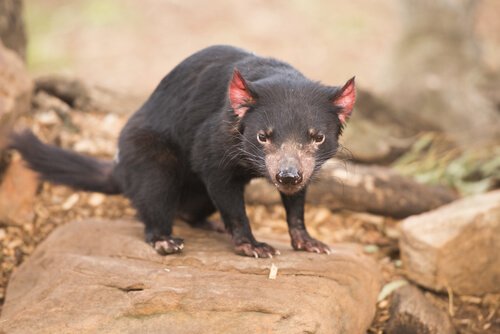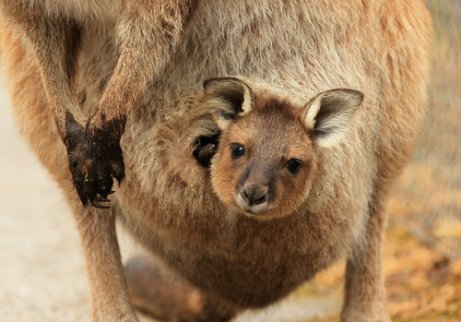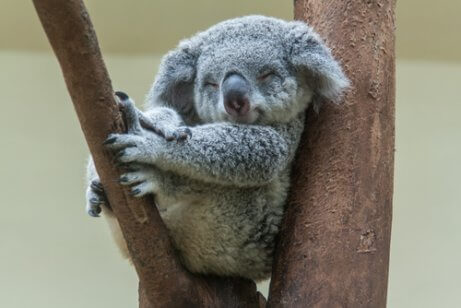Australia: The Land of Marsupials

This unique group of mammals is endemic to America and Australia. But why do people call Australia the land of marsupials? It’s because these animals are the most important terrestrial vertebrates in the country. Of the 378 land mammals that live in Australia, 200 are marsupials.
This land of marsupials has 11,044 protected areas. This is equivalent to an area of 1,487,710 square kilometers or 19.27% of Australia’s total area. These areas were created in part to protect the unique marsupial species.
Marsupials in the world
Currently, there are about 270 species of marsupials in the world. 70 of these are found in America, while 200 are found in Australia.
The most striking feature of marsupials is the marsupium (from the Latin word, meaning ‘pouch’). This is a pouch that consists of a fold of skin that covers the breasts. It also forms an epidermal bag that functions as an incubator chamber.
Young marsupials are born in a state of very incomplete development. In fact, they are almost still fetal. After they are born, they crawl into the marsupium. There, they breastfeed until they are fully developed.
However, depending on the animal, the young will have different distances to travel to reach the bag once they are born. For instance, the Tasmanian devil babies only have to travel a few centimeters. In kangaroos, on the other hand, the marsupium is much further from the birth canal. The young then remain in the pouch for a long time, drinking their mother’s milk, until they are fully developed.
In addition, some marsupials carry their young in their pouch even after gestation has finished. For example, kangaroos carry their young to protect them from possible predators.

The land of marsupials
The true land of marsupials is Australia. This is because it has the largest recorded number of autochthonous marsupial species. Australian marsupials are characterized by how adaptive the species are. In addition to this, they are herbivores and carnivores.
They are also species that, through evolutionary convergence, have a resemblance to rodents or canids. Among marsupials, several stand out, such as kangaroos, koalas, wombats, Tasmanian devils, and the Tasmanian wolf (extinct in 1930).
The colonization of Australia, first by aboriginal inhabitants more than 40,000 years ago, and then by Europeans after 1788, had a strong impact on the country’s fauna. Hunting, the introduction of exotic species, and the consequent destruction of habitats led to many species becoming extinct. This has especially affected marsupials and various plant species.
Carnivorous marsupials
Carnivorous marsupials are represented by two families: the Dasyuridae, which has 52 members, and the Myrmecobiiade, with the Numbat as the sole survivor.
The largest carnivorous marsupial is the Tasmanian devil. It is the size of a small dog and hunts and scavenges. This animal became extinct in Australia 600 years ago but still survives in Tasmania.
There are four species of quoll, or “native cat,” which are all threatened. The rest of this family, the Dasyuridae, are the marsupial mice, most of which weigh less than 100 grams.
There are two species of marsupial moles that inhabit the deserts in Eastern Australia. These subterranean animals are blind, deaf, and carnivorous.
The omnivorous marsupials
These omnivorous animals include bandicoots and bilbies. There are seven species in Australia, and most are endangered. These small creatures have some remarkable physical characteristics. They have a plump body and a long, delicate nose. In addition, they have long, erect ears, powerful legs, and a thin tail.
However, the evolutionary origin of this group is uncertain. This is because they have characteristics of both carnivorous marsupials and herbivores.
The herbivorous marsupials
One of the most popular Australian marsupials is the koala. This is an arboreal species that eats the leaves of 120 species of eucalyptus. Wombats, on the other hand, live on the ground and feed on grass, Cyperaceae, and all kinds of roots.

Possums are a group of arboreal marsupials. These include six families and 26 species, and they differ greatly in size. On the one hand, there are pygmy possums, which are 7 grams. On the other hand, there are the scaly-tailed possum or brushtail possum, which is similar in size to a house cat. These live in the eucalyptus forests of Eastern Australia.
Gliding possums or squirrel gliders have membranes, called patagium, that extend from the fifth finger of its upper extremity to the first toe on the same side. These membranes, when extended, allow them to jump between neighboring trees.
Three families of herbivorous marsupials
Kangaroos, wallabies, bettongs, and rat-kangaroos are grouped into three families. All of them live in Australian habitats except in the alpine climate zones.
- The Hypsiprymnodontidae, of which the musky rat-kangaroo is the only representative.
- The Potoroidae, which has ten species. There are bettongs, potoroo, and rat-kangaroos. This family includes small species that dig burrows and transport plant material with their tails.
- The Macropodidae, which had 53 species in Australia. However, this number has declined due to decreasing populations. Among the most well-known are kangaroos and wallabies. Most Macropods are bipedal with efficient locomotion based on jumping. They have very muscular tails, long hind legs, and long, narrow feet. The hind feet have a distinctive four-finger structure, while the shorter, supper limbs have five separate fingers.
The representatives of the Macropodidae group vary considerably in size. The musky rat-kangaroo is the smallest representative, with a maximum weight of 680 grams. On the other hand, the red kangaroo is the largest, with an approximate height of two meters and a weight of up to 85 kilos.
Because of this great variety of marsupials, Australia is rightly considered the land of marsupials. However, it also has an incomparable amount of other mammals, birds, reptiles, amphibians, fish, and invertebrates. In spite of this, marsupials attract our attention because of their distinctive features.